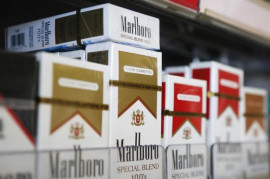
HYDERABAD: The shortage of water in the Indus River in southern Sindh has affected the sowing of crops in the province.
On Saturday, Kotri Barrage received only about 6,500 cusecs of water out of the 23,300 cusecs it should, as decided in the 1991 Water Apportionment Accord.
The cultivation area around Kotri barrage is around 1.53 million acres. It is irrigated by three left bank canals. The fourth canal, Kalri Baglihar Feeder, springs from the right bank. It irrigates parts of Thatta and supplies drinking water to Karachi.
According to the 1991 accord, the water flow has to be around 12,300 cusecs in the first ten days of May. The flow was also low in April. According to the chairman of Indus River System Authority (Irsa), Mazhar Ali Shah, a shortfall of 20 per cent was expected in the water flow in April. “Both Sindh and Punjab had mutually agreed to share the shortfall.”
Shah told The Express Tribune that according to a formula devised by the 1991 accord, the water discharge has to be increased after every 10 days from April till the monsoon rain. “The surge starts from 6,000 cusecs in early April, accrues to 12,000 cusecs in early May and then 18,000 cusecs by the end of May,” he said. “It goes on to increase in the following months until the season changes.”
When asked the reason for the acute paucity of water, chairman Shah attributed it to the late arrival of summer. He categorically denied that Punjab stole from Sindh’s share which was in contrast to an objection he had raised in late April. He had alleged that Punjab was supplying water to Greater Thal Canal from Sindh’s share. But while talking to The Express Tribune he said that Punjab isn’t stealing water but supplying water to Thal canal from its own share.
“The Thal canal is getting 2,300 cusecs,” he claimed. “Punjab contributes 2,000 cusecs from its own share.”
Affect on agriculture
Cotton, rice, sugarcane and a variety of vegetables are grown in southern Sindh. Although no statistics are available to show how much of the land still remains uncultivated the amount of water discharge provide a useful insight.
The kharif season has been particularly tough for the last two years on both banks of Indus River because of the floods.
Sugarcane is the most popular crop in the areas near Kotri Barrage and it needs the most amount of water. According to Mushtaq Nizamani, a farmer, sugarcane needs between 12 to 18 months to mature before they can be harvested. Water stagnated in the fields after the floods last year and eroded the roots of the cane sticks and caused them to rot. Now, not only the farmers can’t harvest their crops they will have to plant sugarcane all over again. Since kharif sowing happens in Sindh first and then Punjab, diverting water from the Chashma-Jehlum (CJ) Link Canal towards Thal canal, which supplies water to southern Punjab, decreases and slows down the flow of water at the areas at the tail end of Indus River. The faster and more the flow of water is, sooner will it reach the downstream areas. But since the water keeps decreasing from the river course the flow not only decreases but also takes longer to reach areas like Kotri and Badin.
Nizamani said that the opening of the CJ link canal every year at the beginning of Kharif season affects the farmers in southern Sindh. “Our lands are dry before the monsoon and then suddenly we are flooded.”
A grower in Badin, Muhammad Khan Sarejo, said that the sowing usually began in early April and May but this year he still hadn’t sown cotton and rice on his fields. “We were promised that we will get irrigation water by May 20,” he said, but understandably he is skeptical if the pledge will be honoured. “Even if we get water all the fields can’t be seeded because there will not be enough time.”
Some areas like Thatta, which are on the right bank of River Indus, have been the lucky to receive irrigation water by the Kalri-Baghar Feeder. However farmers in other areas, such as Kotri and Tando Mohammad Khan still wait for water to plant their crops.
Published in The Express Tribune, May 7th, 2012.




















































COMMENTS
Comments are moderated and generally will be posted if they are on-topic and not abusive.
For more information, please see our Comments FAQ